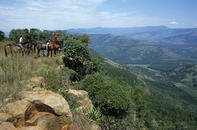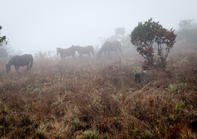The Perfect Place to Unwind
Over the past decade Kaapsehoop has a bit of a secret artist’s getaway. Among the most quaint of places anywhere in South Africa (think Rhodes village, Pilgrim’s Rest or Nieu Bethesda). It’s not really on the way to or from anywhere.

There are lots of trees, and also feral horses that live around the town. Horseback riding is a popular pastime in the area. Story goes it was such a buzzing place in days in the late 1800s it had the country’s first stock exchange. Around 20 years ago it was an old mining ghost town, what Pilgrim’s Rest might be had it not been turned into a tourist town.
There are now lots of new holiday houses, restaurant-pubs and B&Bs in the village. Still, it’s one of the best you’ll ever see. Considered to be South Africa’s most endangered bird, blue swallows can be found here. If you're lucky, in the Limpopo Province where they nest in old sinkholes, or in Mpumalanga near Kaapsehoop. Alternatively visit Nyika Plateau in Malawi for a sure sighting.
The Fairytale Village

Kaapsehoop is situated just 30 km south-west of Nelspruit on the edge of the Mpumalanga escarpment. This fairy-tale village is well known for its mist and wild horses that roam free in the area. Weathered sandstone formations, spectacular views, historic sites and pristine nature trails are just a few of the reasons to return here time and again.
Originally known as Duiwels Kantoor (or Devil’s Office), the town was renamed Kaapsche Hoop in the 1880s because the unusual rock formations and swirling mists brought the Cape’s Table Mountain to mind. Kaapsehoop will enchant you with its unique climate of wet misty summers.
Expect it to be rather cold in winter, but the herds of wild horses, interesting locals, breathtaking views over De Kaap Valley and delightful shops (such as the Ou Kaapsehandelhuis) will keep you coming back. The most pristine area is the Blue Swallow Conservancy Area. The area to the North and West is dominated by pine plantations belonging to Sappi and Komatiland Forestry.